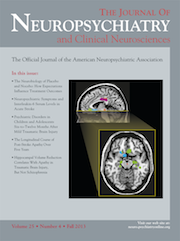To the Editor: Excessive daytime sedation (EDS) is a common and disabling side effect of antipsychotics (AP). We report on a case of a 17-year-old patient with difficult-to-treat symptoms of obsessive-compulsive disorder, chronic tic disorder, and primary derealization syndrome, whose compliance was noted to be poor because of AP-induced EDS. We successfully used modafinil for the treatment of this AP-related EDS, but with initial exacerbation of tics. This report highlights the need for careful dose-titration of modafinil, especially in those with past or family history of tic disorders.
Excessive daytime sedation (EDS) is a common and disabling side effect of antipsychotics (AP), often leading to treatment noncompliance. EDS can be treated with activating agents such as modafinil or stimulants or by stopping the sedating APs. We report on a case with successful use of modafinil for the treatment of AP-induced EDS, but with initial worsening of tics.
A 17-year-old boy presented to the hospital outpatient services with a 3-year history of derealization, pathological doubts, aggressive and superstitious obsessions, re-reading and re-writing compulsions; and excessive blinking, facial grimacing, quick movements of the arms and legs, and grunting sounds. There was a family history of tic disorder in the mother and maternal aunt. He was diagnosed with obsessive-compulsive disorder (OCD), chronic tic disorder, and primary derealization syndrome. He was treated with fluvoxamine 200 mg/day and risperidone 2 mg/day. Compliance was noted to be poor because of sedation. Treatment was changed to fluoxetine 40 mg/day and haloperidol 2 mg/day. With this, there was 90% improvement in his tics and significant improvement in OCD. In view of the patient’s continuing complaint of lack of alertness during the day, modafinil 200 mg/day was added. After adding modafinil, a worsening of tics was noted; hence, the dose was decreased to 150 mg/day. In the next follow-up, after 2 months, the patient reported 80% improvement in tics. The score on the Naranjo ADR Probability Scale was 8, which scores as Probable. The total tic score on the Yale Global Tic Severity Scale was 15/50 (before modafinil), 40/50 (on modafinil), and 16/50 (after reducing modafinil dose).
Modafinil has been traditionally used to reduce excessive sleepiness in patients with narcolepsy and shift-work sleep disorder. There is preliminary evidence for its successful use in AP-induced EDS.
1,2 In this patient, addition of modafinil at 200 mg/day led to significant improvement in EDS, but was associated with worsening of tics. However, with a titration of its dose down to 150 mg/day, tics were brought under control.
There are reports of stimulant-associated exacerbation of tics,
3,4 but causal relationship has been debatable.
5 Use of a nonstimulant like modafinil in appropriate dosage can lead to effective amelioration of EDS without marked worsening of tics, as demonstrated in our report.
The precise pathophysiological link behind exacerbation of tics and modafinil’s mechanism in promoting wakefulness remains unclear. It is believed that it increases synaptic dopamine following blockade of dopamine transport. This leads to increased tonic firing and downstream effects on neurotransmitters involved in wakefulness, as against phasic dopamine firing seen with classic stimulants like amphetamine and methylphenidate, promoting reinforcement and abuse. Tonic dopamine leads to release of histamine from the tuberomamillary nucleus of the posterior hypothalamus and then further activation of the lateral hypothalamus, with orexin release to stabilize wakefulness. This increase in synaptic dopamine is also believed to be associated with exacerbation of tics. This can be managed by careful titration of modafinil dosage and also the use of Dopamine-2 receptor antagonists.

